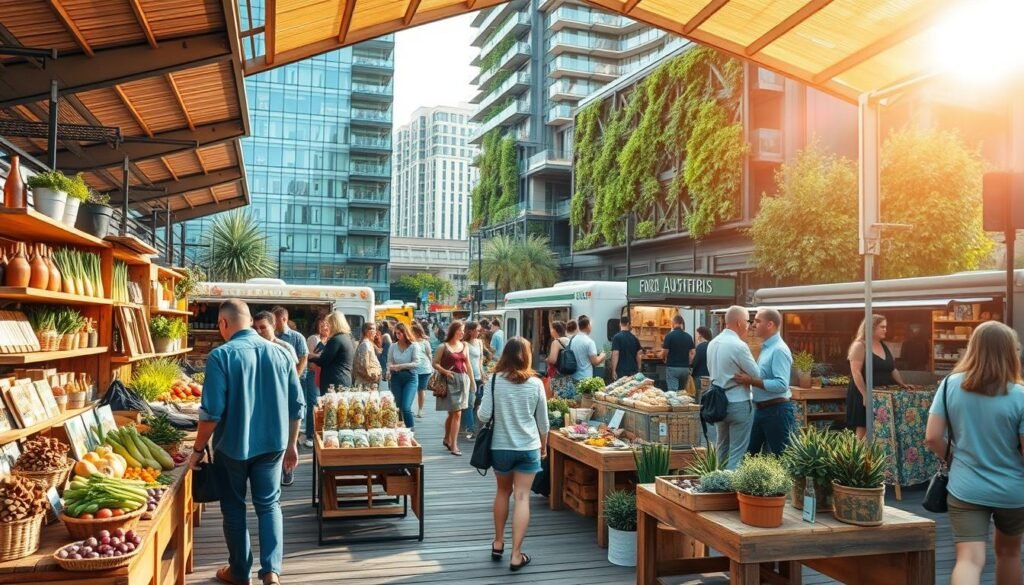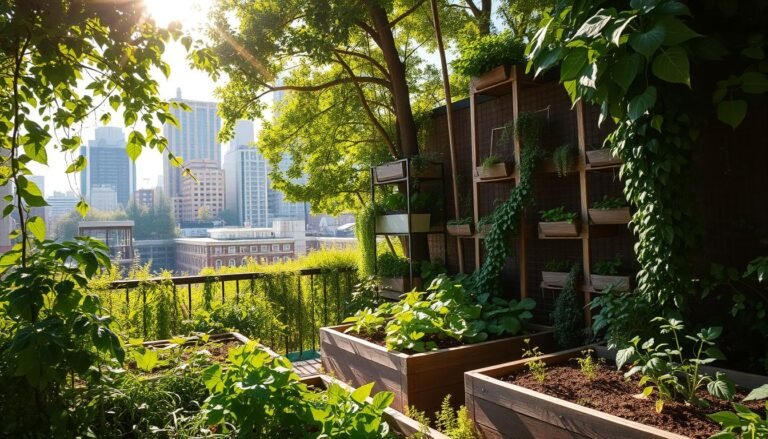As consumers become increasingly environmentally aware, the demand for eco-friendly experiences is on the rise. This shift is driving a fundamental transformation in how businesses engage with customers, with brands now expected to align with their environmental values.
The conscious lifestyle movement is gaining momentum, influencing consumer preferences and shaping the sustainable consumer journey. Brands are adapting to meet this growing demand, redefining their practices to prioritize sustainability and ethical considerations.
This transformation is not just about changing consumer behavior; it’s also about how businesses respond to these new expectations. By embracing sustainability, brands can create a more meaningful connection with their customers.
Key Takeaways
- A growing number of consumers are seeking eco-friendly products and services.
- Brands are adapting their practices to meet the demand for sustainability.
- The conscious lifestyle movement is influencing consumer preferences.
- Businesses are redefining their engagement strategies to prioritize sustainability.
- A sustainable consumer journey is becoming a key differentiator for brands.
The Evolution of Sustainability from Product to Experience
The evolution of sustainability is marked by a shift from product-centric approaches to more holistic, experiential strategies that resonate with conscious consumers. As people become more environmentally aware, their expectations from brands are changing. They’re no longer satisfied with just buying green products; they want to be part of a sustainable lifestyle that encompasses a broader range of experiences.
Beyond Green Products: The Birth of Experiential Sustainability
Experiential sustainability is about creating immersive experiences that connect consumers with the brand’s values and mission. It’s an approach that goes beyond the transactional, focusing on building a relationship between the consumer and the brand. For instance, workshops, eco-friendly events, and interactive online platforms are becoming increasingly popular as they offer a more engaging way to promote sustainability.
How Consumer Values Are Reshaping Brand Strategies
Consumer values are driving brands to rethink their strategies, placing a greater emphasis on sustainability and ethical practices. Brands are now expected to not only offer high-quality, eco-friendly products but also to contribute positively to the community and the environment. This shift is leading to innovative brand strategies that prioritize transparency, circular economy practices, and community engagement, ultimately enhancing the sustainable consumer journey.
By focusing on eco-friendly experiences, brands can create a deeper connection with their customers, fostering loyalty and advocacy. This approach not only benefits the environment but also drives business growth by meeting the evolving needs of the conscious consumer.
The Australian Sustainable Consumer: Attitudes and Behaviours
As sustainability becomes more mainstream, Australian consumers are redefining their attitudes and behaviours towards a more conscious lifestyle. This shift is driven by a growing awareness of environmental issues and a desire to make a positive impact through daily choices.
Environmental Consciousness in the Australian Market
Australian consumers are increasingly prioritizing environmental consciousness in their purchasing decisions. This is reflected in the growing demand for eco-friendly products and services that minimize harm to the environment.
Health and Wellness as Sustainability Drivers
The pursuit of health and wellness is another significant driver of sustainability in the Australian market. Consumers are seeking products and experiences that not only benefit the planet but also contribute to their personal well-being.
The Social Impact of Conscious Consumption
Conscious consumption is also influenced by the social impact of purchasing decisions. Australians are becoming more aware of the social implications of their choices, favouring brands that demonstrate a commitment to social responsibility and ethical practices.
The sustainable consumer journey in Australia is characterized by a complex interplay of environmental, health, and social factors. Understanding these dynamics is crucial for businesses aiming to connect with the evolving values and behaviours of Australian consumers.
Creating Emotional Connections Through Sustainable Experiences
In today’s eco-conscious market, creating sustainable experiences is no longer just about the product – it’s about crafting an emotional connection with the consumer. This shift towards eco-friendly experiences is driven by a growing demand for a conscious lifestyle, where consumers seek more than just a product; they crave experiences that resonate with their values.
The Psychology of Eco-Friendly Decision Making
The psychology behind eco-friendly decision-making is complex, involving a mix of personal values, social norms, and environmental awareness. Consumers are more likely to engage in sustainable behaviors when they feel a sense of belonging to a community that values the environment. Brands can tap into this by creating experiences that foster a sense of community and shared values.
How Values Alignment Builds Brand Loyalty
When brands align with consumer values, they build trust and loyalty. This alignment is crucial in the sustainable consumer journey, as consumers are more likely to remain loyal to brands that share their commitment to sustainability. By creating eco-friendly experiences, businesses can strengthen their brand identity and foster long-term relationships with their customers.
Australian Pioneers: Brands Leading the Sustainable Experience Movement
The sustainable experience movement is gaining momentum in Australia, thanks to forward-thinking brands that are innovating across various sectors.
Flora & Fauna: Revolutionising Plastic-Free Shopping
Flora & Fauna is making waves with its plastic-free shopping experience. By offering a wide range of products without single-use plastics, they are setting a new standard for retail. Their commitment to sustainability is evident in their business model, which encourages customers to bring their reusable containers and bags.

Koala: Circular Economy in Furniture Retail
Koala is pioneering the circular economy in furniture retail. Their innovative approach includes furniture rental services and a buy-back program, reducing waste and promoting sustainable consumption. This not only minimizes environmental impact but also offers customers flexibility and affordability.
| Brand | Sustainability Initiative | Impact |
|---|---|---|
| Flora & Fauna | Plastic-free shopping | Reduction in single-use plastics |
| Koala | Furniture rental and buy-back | Minimized waste and promoted sustainable consumption |
| Who Gives A Crap | Donation of profits to sanitation charities | Improved sanitation in developing countries |
Who Gives A Crap: Making Sustainability Engaging
Who Gives A Crap is not only selling eco-friendly toilet paper but is also making a significant social impact. By donating a significant portion of their profits to charities that provide sanitation in developing countries, they are engaging consumers in a meaningful cause. Their transparent business practices and commitment to giving back are key factors in their success.
These Australian brands are leading by example, showing that sustainability can be both practical and engaging. As consumers become more environmentally conscious, the demand for eco-friendly experiences is likely to grow, and these pioneers are well-positioned to meet this demand.
Reimagining the Retail Experience Through Sustainability
As consumers increasingly prioritize sustainability, retailers are transforming the shopping experience to meet these evolving expectations. This transformation is not just about adopting eco-friendly practices but also about creating an immersive and engaging experience that resonates with the conscious consumer.
Zero-Waste Store Designs in Australian Cities
Australian retailers are at the forefront of adopting zero-waste store designs. For instance, some stores are using recycled materials for fixtures and fittings, minimizing packaging, and incorporating composting programs for food waste. Flora & Fauna, a Sydney-based retailer, has pioneered plastic-free shopping experiences, setting a new standard for eco-friendly retail.
Interactive Education in Eco-Retail Spaces
Retailers are leveraging interactive education to engage customers on sustainability issues. Stores are incorporating workshops, digital displays, and in-store events to educate consumers about sustainable living. For example, Koala, a furniture retailer, uses in-store displays to highlight the benefits of circular economy practices in furniture retail.
Innovative Packaging Solutions at Point of Sale
Innovative packaging solutions are being implemented at the point of sale to reduce waste. Retailers are adopting biodegradable packaging, refill stations, and minimal packaging designs. Who Gives A Crap, a toilet paper retailer, is known for its humorous approach to sustainability, using recycled materials for packaging and promoting sustainable living through its products.
| Retailer | Sustainability Initiative | Impact |
|---|---|---|
| Flora & Fauna | Plastic-free shopping | Reduced plastic waste |
| Koala | Circular economy practices | Increased sustainable furniture sales |
| Who Gives A Crap | Biodegradable packaging | Reduced packaging waste |
The Digital Sustainable Experience: Online Eco-Innovations
The digital landscape is evolving to meet the demands of eco-conscious consumers. As a result, e-commerce platforms are adopting innovative strategies to reduce their environmental footprint.
Carbon-Neutral E-Commerce Platforms
E-commerce giants are transitioning to carbon-neutral practices, offsetting emissions from operations and supply chains. This shift not only reduces environmental impact but also enhances brand reputation among eco-conscious consumers.
Virtual Try-On Technology Reducing Returns Waste
The adoption of virtual try-on technology is significantly reducing returns in online fashion retail. By allowing customers to try products virtually, brands minimize waste and lower carbon emissions associated with return shipping.
Sustainable UX Design Principles
Sustainable UX design focuses on creating intuitive, energy-efficient digital experiences. Key principles include:
- Simplifying navigation to reduce cognitive load
- Optimizing images to decrease page load times and energy consumption
- Implementing dark mode to reduce screen energy usage
By integrating these principles, brands can enhance the sustainable consumer journey and promote a conscious lifestyle.
From Farm to Table: The Sustainable Food Experience
In the pursuit of a more conscious lifestyle, the Australian food scene is embracing sustainability from farm to table. This shift is driven by consumers who are increasingly demanding eco-friendly experiences and are willing to support businesses that prioritize sustainability.
Australian Farm-to-Table Restaurant Innovations
Farm-to-table restaurants are at the forefront of this movement, showcasing the best of Australian produce while minimizing their environmental footprint. These establishments are redefining the sustainable consumer journey by promoting locally sourced ingredients and reducing food waste.
Zero-Waste Cooking and Menu Engineering
Zero-waste cooking is gaining traction, with chefs creatively utilizing every part of the ingredient to minimize waste. This approach not only reduces the environmental impact but also offers a unique culinary experience.
Compostable Packaging in Food Delivery Services
Food delivery services are also adopting sustainable practices by switching to compostable packaging. This change is a significant step towards reducing plastic waste and promoting eco-friendly experiences.
| Sustainable Practice | Impact | Benefit |
|---|---|---|
| Farm-to-Table | Reduces transportation emissions | Promotes local farmers |
| Zero-Waste Cooking | Minimizes food waste | Encourages creative cuisine |
| Compostable Packaging | Reduces plastic waste | Enhances eco-friendly image |
By embracing these sustainable practices, the food industry is not only contributing to a healthier environment but also enhancing the dining experience for consumers. As the demand for sustainable food experiences continues to grow, it is likely that more innovations will emerge, further transforming the way we enjoy food.
Fashion Revolution: Transforming the Wardrobe Experience
The traditional fashion industry is undergoing a significant transformation, embracing eco-friendly experiences and sustainable consumer journeys. This shift is driven by consumer demand for more conscious lifestyle choices.
Australian Fashion Rental and Subscription Services
Australian fashion rental and subscription services are gaining popularity, offering consumers a more sustainable alternative to fast fashion. Brands are now focusing on providing high-quality, durable clothing that can be rented or subscribed to, reducing the need for frequent purchases and waste.
Repair Cafés and Upcycling Workshops
Repair cafés and upcycling workshops are becoming increasingly popular, encouraging consumers to repair and reuse their clothing rather than discarding it. This not only reduces waste but also fosters a community around sustainable fashion practices.
Supply Chain Transparency in Fashion Retail
Supply chain transparency is becoming a critical issue in fashion retail, with consumers demanding more information about the origin and production processes of their clothing. Brands are responding by implementing more transparent supply chains, ensuring that their practices align with consumer values.

| Sustainable Practice | Impact |
|---|---|
| Fashion Rental Services | Reduces the need for new, resource-intensive garments |
| Repair Cafés | Extends the life of existing garments, reducing waste |
| Supply Chain Transparency | Builds trust with consumers, ensuring ethical production practices |
By embracing these sustainable practices, the fashion industry is not only reducing its environmental impact but also creating a more conscious and engaged consumer base.
The Sustainable Home Experience: Eco-Living Innovations
As Australians become more environmentally conscious, their homes are becoming hubs for eco-friendly experiences. This shift is driven by a growing demand for sustainable living solutions that not only reduce environmental impact but also enhance the quality of life.
Energy-Efficient Smart Home Technologies
Smart home technologies are revolutionizing the way Australians live by making their homes more energy-efficient. Smart thermostats and energy monitors are becoming increasingly popular, allowing homeowners to optimize their energy usage and reduce their carbon footprint.
Water Conservation Systems
Water conservation is another critical aspect of sustainable home living. Australians are adopting innovative water-saving technologies such as rainwater harvesting systems and greywater recycling to minimize their water usage.
Sustainable Interior Design
Sustainable interior design services are also on the rise, with homeowners opting for eco-friendly materials and products. This includes using reclaimed wood, low-VOC paints, and sustainable textiles to create beautiful and environmentally friendly living spaces.
| Innovation | Benefits | Examples |
|---|---|---|
| Smart Home Technologies | Energy efficiency, reduced carbon footprint | Smart thermostats, energy monitors |
| Water Conservation Systems | Water savings, reduced waste | Rainwater harvesting, greywater recycling |
| Sustainable Interior Design | Eco-friendly materials, improved indoor air quality | Reclaimed wood, low-VOC paints, sustainable textiles |
By embracing these eco-living innovations, Australians are not only reducing their environmental impact but also creating more sustainable and enjoyable living spaces.
Redefining the Travel Experience Through Sustainability
Sustainability is revolutionizing the way we travel, offering eco-friendly experiences that align with the conscious lifestyle. As travelers become more environmentally aware, the industry is responding with innovative sustainable practices.
Eco-Tourism in Australia’s Protected Landscapes
Australia’s unique landscapes are being preserved through eco-tourism initiatives. These programs not only support conservation efforts but also provide visitors with unforgettable experiences in nature.
Carbon-Offset Programs for Domestic Travel
Carbon-offset programs are becoming increasingly popular for domestic travel. By investing in these programs, travelers can offset their carbon footprint, supporting projects that reduce greenhouse gas emissions.
Sustainable Accommodation Innovations
Accommodations are also being redefined with sustainability in mind. From eco-friendly hotels to sustainable camping options, travelers have a range of choices that minimize environmental impact.
| Sustainable Travel Option | Description | Environmental Impact |
|---|---|---|
| Eco-Tourism | Guided tours in protected areas | Low |
| Carbon-Offset Programs | Compensating for carbon emissions | Reduced |
| Sustainable Accommodations | Eco-friendly hotels and lodges | Minimal |
Beauty Without Compromise: The Clean Beauty Experience
The clean beauty movement is revolutionizing the way Australians experience personal care, prioritizing eco-friendly practices and sustainability. This shift is driven by consumers who are increasingly conscious of the environmental and health impacts of their beauty choices.
Refill Stations and Zero-Waste Beauty Retail
Refill stations are becoming a staple in Australian beauty retail, allowing customers to replenish their favorite products while reducing packaging waste. Brands are adopting zero-waste retail strategies, encouraging consumers to return empty containers for recycling or refilling. For example, some stores offer incentives for customers who participate in refill programs, fostering a sense of community and shared responsibility for the environment.
Australian Native Ingredients in Sustainable Formulations
The use of Australian native ingredients is on the rise in clean beauty formulations. These ingredients are not only effective but also sustainable, as they are often sourced from plants that are well-adapted to the Australian climate. Brands are leveraging these ingredients to create products that are both effective and environmentally friendly. For a deeper dive into the world of non-toxic skincare, visit 100% Pure’s guide on the topic.
Transparent Sourcing and Ethical Production Stories
Transparency is key in the clean beauty movement. Consumers are demanding more information about the sourcing and production processes behind their beauty products. Brands are responding by sharing ethical production stories and highlighting their commitment to sustainable practices. Some key aspects include:
- Sourcing ingredients from environmentally responsible suppliers
- Ensuring fair labor practices in production facilities
- Reducing carbon footprint through eco-friendly packaging and distribution
By embracing these practices, Australian beauty brands are not only enhancing their products but also contributing to a more sustainable future for the industry.
Technology Enabling Better Sustainable Experiences
The integration of cutting-edge technologies is revolutionizing the way we experience sustainability. As consumers increasingly demand eco-friendly experiences, businesses are leveraging technologies like blockchain, AI, and augmented reality to meet these expectations.
Blockchain for Supply Chain Transparency
Blockchain technology is enhancing supply chain transparency, a critical factor in sustainable consumer journeys. By utilizing blockchain, companies can provide a tamper-proof record of their supply chain operations.
Real-Time Product Journey Tracking
This allows consumers to track the origin and journey of products in real-time, fostering trust and accountability.
Verifying Ethical Claims
Blockchain also enables the verification of ethical claims made by brands, ensuring that their sustainability assertions are backed by concrete data.
AI-Powered Sustainable Shopping Assistants
AI-powered shopping assistants are being developed to guide consumers towards more sustainable choices. These tools analyze consumer preferences and suggest eco-friendly alternatives, making sustainable shopping more accessible.
Augmented Reality for Conscious Consumption
Augmented reality (AR) is another technology being harnessed to promote conscious consumption. By allowing consumers to visualize products in their own environment before purchase, AR reduces the likelihood of returns and waste.
These technologies are collectively enhancing the sustainable consumer journey, making eco-friendly experiences more engaging and accessible. As technology continues to evolve, we can expect even more innovative solutions to emerge, further redefining the landscape of sustainable living.
Measuring What Matters: Quantifying the Sustainable Experience
The shift towards a more sustainable future necessitates a deeper understanding of how to measure the effectiveness of eco-friendly initiatives. As consumers increasingly adopt a conscious lifestyle, businesses are under pressure to deliver eco-friendly experiences that not only meet but exceed consumer expectations.
Quantifying the sustainable experience involves more than just tracking carbon footprints. It requires a holistic approach that considers various aspects of the sustainable consumer journey.
Beyond Carbon: Holistic Impact Metrics
Businesses are moving beyond traditional carbon metrics to adopt more comprehensive impact assessments. This includes evaluating the social, environmental, and economic impacts of their sustainability initiatives. For instance, a company might assess the water usage, waste reduction, and community engagement efforts alongside their carbon emissions.
| Impact Area | Metrics | Example |
|---|---|---|
| Environmental | Carbon footprint, water usage, waste reduction | Reducing carbon emissions by 20% annually |
| Social | Community engagement, labor practices | Partnering with local organizations for sustainability workshops |
| Economic | Cost savings, job creation | Creating jobs through sustainable supply chain practices |
Consumer Feedback Loops for Continuous Improvement
Incorporating consumer feedback is crucial for continuous improvement in sustainability. Businesses can use various mechanisms, such as surveys, social media listening, and product feedback forums, to understand consumer perceptions and preferences regarding their eco-friendly experiences. This feedback loop enables companies to refine their sustainability strategies and better align with consumer values.
“The key to successful sustainability lies in understanding and responding to consumer needs while maintaining a commitment to environmental stewardship.”
By adopting holistic impact metrics and leveraging consumer feedback, businesses can enhance their sustainability efforts and create more meaningful eco-friendly experiences for their customers.
Authenticity Challenges: Navigating the Green Experience Economy
As consumers increasingly demand eco-friendly experiences, brands face significant challenges in maintaining authenticity in their sustainability claims. The green experience economy is built on trust, and any perceived dishonesty can lead to a loss of customer loyalty and damage to a brand’s reputation.
Identifying and Avoiding Greenwashing
Greenwashing is a significant threat to the authenticity of the green experience economy. Brands must be transparent in their sustainability claims and avoid making false or misleading statements. To identify greenwashing, consumers can look for third-party certifications and check if a brand’s actions align with its claims.
Balancing Sustainability with Consumer Convenience
Consumers expect sustainable products and services to be convenient and accessible. Brands must balance their sustainability goals with consumer needs, ensuring that eco-friendly options are not only available but also appealing. This can be achieved by integrating sustainable practices into the consumer journey, making it easy for customers to make environmentally friendly choices.
The Future of the Sustainable Experience: Emerging Trends
The sustainable experience is evolving, with regenerative business models and community-centered eco-initiatives at the forefront. As consumers increasingly demand more than just eco-friendly products, brands are responding with innovative approaches that not only reduce environmental impact but also promote ecological regeneration.
Regenerative Business Models Beyond Sustainability
Regenerative business models are redefining the way companies operate, shifting from mere sustainability to actively restoring and enhancing ecosystems. For instance, regenerative agriculture practices are being adopted by forward-thinking brands to improve soil health, biodiversity, and ecosystem services. This approach not only reduces the environmental footprint but also contributes to the overall health of the planet.
Community-Centered Eco-Initiatives in Australia
Community-centered eco-initiatives are gaining momentum in Australia, with local communities driving environmental change through collaborative efforts. Examples include community-led conservation projects, local clean-up initiatives, and eco-education programs. These initiatives not only foster a sense of community but also promote environmental stewardship.
| Initiative | Location | Impact |
|---|---|---|
| Community Conservation Project | NSW | Restored 100 hectares of native habitat |
| Local Clean-up Initiative | VIC | Collected 5 tons of recyclable waste |
| Eco-Education Program | QLD | Educated 1,000 students on sustainable practices |
Conclusion: Embracing the Sustainable Experience Revolution
As consumers increasingly demand eco-friendly experiences, businesses must adapt to remain relevant, driving the sustainable experience revolution forward.
This shift towards a conscious lifestyle is redefining the way companies operate, with a focus on creating a seamless sustainable consumer journey.
By embracing sustainability, businesses can improve brand image, increase customer loyalty, and reduce costs, ultimately driving long-term success.
The future of sustainable experiences in Australia looks promising, with brands like Flora & Fauna, Koala, and Who Gives A Crap leading the way.
As the sustainable experience revolution continues to gain momentum, it’s essential for businesses to stay ahead of the curve, innovating and adapting to meet the evolving needs of the conscious consumer.





